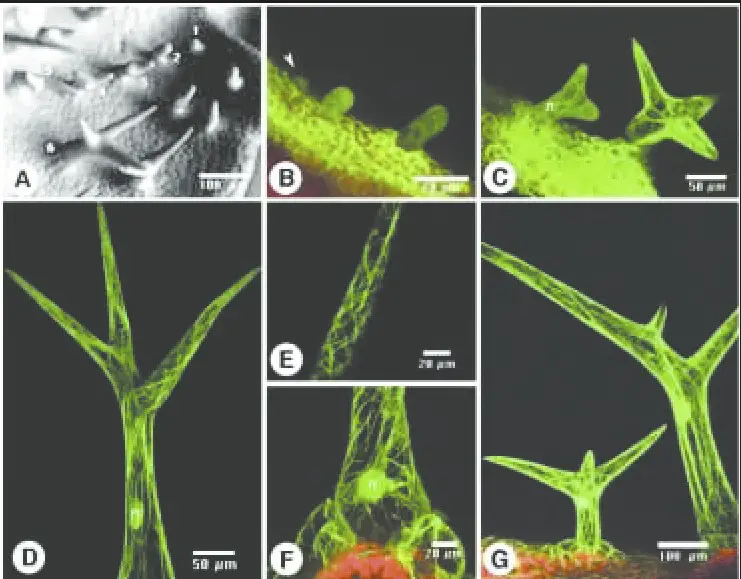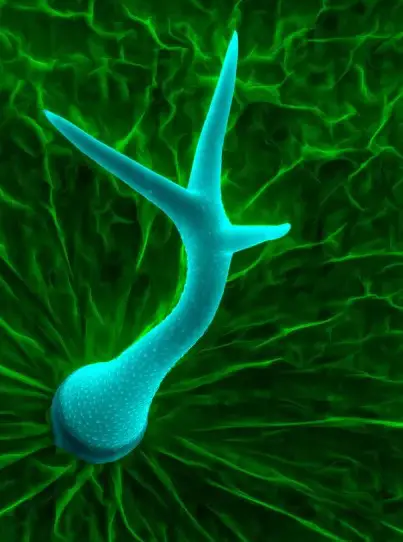Plants are marvels of nature, equipped with various structures that serve specialized functions, crucial for their survival and reproduction. Among these, trichomes and filaments stand out for their distinctive roles and appearances. Although they are less talked about outside botanical circles, understanding these components can provide deep insights into plant biology and the intricate ways plants interact with their environment.
Trichomes and filaments are fundamental plant structures with distinct roles. Trichomes, often visible as tiny hairs on the plant surface, serve various functions including protection from predators and environmental stressors. Filaments, on the other hand, are part of a flower’s stamen and play a critical role in the reproductive process by supporting the anther, which produces pollen. These differences are not merely structural but also highlight their varied contributions to a plant’s life cycle and interaction with its surroundings.
The significance of trichomes extends beyond mere protection; they are also involved in the plant’s defense mechanisms against herbivores and in reducing water loss. Similarly, filaments are not just structural supports; they are vital for the successful transfer of pollen, thereby ensuring the plant’s reproductive success. Such functions underscore the complexity of plant anatomy and the evolutionary adaptations that have enabled plants to thrive in diverse environments.

Trichome Overview
Definition and Function
Trichomes are small, hair-like structures found on the surface of plants. They serve a multitude of functions, ranging from protecting the plant against various threats to aiding in reproduction. Trichomes can be seen with the naked eye, appearing as fine fuzz on leaves and stems. Their roles in a plant’s life are critical, including defense against herbivores and insects, UV radiation filtering, and water retention.
Types of Trichomes
Trichomes vary significantly in structure and function, leading to their classification into mainly two types: glandular and non-glandular trichomes.
- Glandular Trichomes: These are specialized structures capable of producing and storing substances that can be secreted. They play a pivotal role in the production of essential oils, offering chemical defense against pests and diseases. For example, the glandular trichomes of the mint family are well-known for their aromatic compounds.
- Non-Glandular Trichomes: Unlike their glandular counterparts, non-glandular trichomes do not produce substances. Their primary function is physical defense. By creating a barrier or deterring herbivores with their structure, they protect the plant. Cotton fibers are a well-known example of non-glandular trichomes.
Significance in Nature
Trichomes have a profound impact on plant interaction with the environment. Their protection mechanisms include deterring herbivores through physical or chemical means and reducing water loss by trapping moisture, which is particularly beneficial in arid climates. Moreover, trichomes contribute to a plant’s interaction with its surroundings by influencing pollinator behavior, where certain trichome patterns can attract or repel pollinators, thereby affecting pollination success.
Filament Overview
Definition and Purpose
A filament is a slender structure in flowering plants, part of the stamen, which is the male reproductive organ. The primary purpose of the filament is to support the anther, enabling effective pollen transfer. Filaments are crucial for plant anatomy as they facilitate the process of fertilization by ensuring that pollen reaches the stigma of a flower.
Filament in Plant Reproduction
The role of filaments in plant reproduction cannot be overstated. They are instrumental in:
- Supporting the anther: By holding the anther in an optimal position, filaments ensure that pollen is efficiently transferred to pollinators or directly to the stigma in self-pollinating plants.
- Facilitating pollen transfer: This is crucial for the production of seeds and the propagation of plant species, contributing significantly to plant diversity.
Structural Characteristics
Filaments exhibit a variety of structural characteristics that differ across plant species. These include:
- Composition: Generally composed of vascular tissue that provides nutrients to the anther.
- Structure: Varies in length and thickness, affecting the stamen’s positioning relative to the rest of the flower.
These differences play a significant role in a plant’s reproductive strategy and success, affecting everything from pollinator attraction to the mechanics of pollen release.
Key Differences
Morphology and Structure
The morphological and structural differences between trichomes and filaments are distinct. Trichomes are external, often hair-like appendages that can cover leaves, stems, and other parts of the plant. Filaments, conversely, are internal components of the flower’s stamen, dedicated to reproductive functions.
Biological Functions
The biological functions of trichomes and filaments underscore their distinct roles in plant life. Trichomes are primarily involved in protection and environmental interaction, while filaments are focused on reproduction, supporting the anther for effective pollen distribution.
Ecological Importance
Both structures have profound ecological importance. Trichomes play a key role in protecting plants from herbivores and environmental stressors, contributing to the survival and fitness of plant species. Filaments support biodiversity by ensuring the successful reproduction of flowering plants, which are a vital part of many ecosystems.

Common Confusions
Trichomes vs. Stigmas
A frequent source of confusion, trichomes and stigmas serve very different functions in the plant world. Trichomes are external, hair-like structures that can be found on leaves, stems, and flowers. Their primary roles include protection from UV radiation, herbivores, and excessive water loss. Stigmas, in contrast, are part of the plant’s reproductive organ, specifically the female part of the flower. They serve as the site for pollen reception. Understanding these distinctions is crucial for both botanists and gardeners in identifying plant parts and their functions.
Filaments vs. Stems
Filaments are slender structures that support the anther in the stamen of a flower, playing a critical role in the plant’s reproductive process. Stems, on the other hand, are the main support system of the plant, transporting fluids between roots and leaves, and often serving as storage tissues. Both are essential to plant health and survival but function in significantly different capacities.
Role in Agriculture and Horticulture
Trichomes in Crop Protection
In the realm of agriculture and horticulture, trichomes have been recognized for their natural pest control capabilities. They can deter herbivores and insects from damaging crops through physical barriers or chemical deterrents. This trait is particularly valuable in reducing the reliance on chemical pesticides, leading to more sustainable farming practices. Researchers and farmers alike are exploring breeding and cultivation techniques to enhance trichome density in crops as a method of natural pest management.
Filaments in Plant Breeding
The role of filaments in plant breeding is indispensable. By supporting the anther, filaments ensure effective pollen transfer, a critical step in the fertilization process. This has profound implications for crop diversity and food security. Cross-pollination strategies, facilitated by the structure and function of filaments, can lead to the development of crop varieties with desirable traits such as improved resistance to pests and diseases, enhanced nutritional value, and better yield.
Practical Applications
In Medicine
The application of trichomes in medicine is a field of growing interest. Many medicinal plants have trichomes that produce bioactive compounds beneficial for health. For instance, the trichomes of the cannabis plant produce cannabinoids, which have therapeutic properties. The detailed study and understanding of trichomes’ role in synthesizing these compounds are leading to advances in pharmaceutical research, offering promising new treatments for a range of conditions.
In Biotechnology
The genetic engineering of trichomes and filaments represents a frontier in biotechnology. Scientists are exploring ways to manipulate the genetic makeup of these structures to enhance their beneficial properties. For trichomes, this could mean increasing the production of essential oils and medicinal compounds. For filaments, genetic modifications could improve pollen viability and transfer, enhancing crop fertilization and yield. These modifications have the potential to revolutionize agricultural practices, making them more sustainable and productive.
Frequently Asked Questions
What are trichomes?
Trichomes are small, often hair-like structures on the surface of plants. They serve various functions, including protecting the plant from pests and diseases, reducing water loss, and sometimes even participating in the plant’s reproduction process by trapping pollen. Their presence and abundance can significantly affect a plant’s health and its ability to survive in its environment.
How do filaments contribute to plant reproduction?
Filaments are slender stalks that support the anther, the part of a flower’s stamen that produces pollen. In plant reproduction, filaments play a critical role by positioning the anther optimally for pollen transfer, either by wind or pollinators. This structural arrangement facilitates the efficient dissemination of pollen to the stigma of the same or another flower, initiating the fertilization process.
Can trichomes and filaments be found on all plants?
Not all plants have trichomes and filaments. Trichomes are more common in certain species, especially those in arid or nutrient-poor environments where their protective functions are crucial. Filaments, being a part of the reproductive organs of flowering plants, are found exclusively in angiosperms. Non-flowering plants, such as ferns and mosses, do not possess these structures.
Why are trichomes important for plants?
Trichomes play a multifaceted role in plant survival. They protect plants from herbivorous animals by producing substances that can be toxic or deter feeding. Trichomes also shield plants from excessive sunlight and help in reducing water loss through evaporation by trapping moisture around the plant surface. Their importance is further highlighted in certain plants used for medicinal purposes, where trichomes are the primary sites for the synthesis of valuable secondary metabolites.
Conclusion
The exploration of trichomes and filaments unveils the complexity and ingenuity of plant anatomy, highlighting the evolutionary strategies plants have adopted to navigate their ecological niches. These structures, though small and often overlooked, play pivotal roles in the survival, reproduction, and overall health of plants. Their study not only enriches our understanding of plant biology but also opens avenues for agricultural and medicinal applications, showcasing the intricate connections between form, function, and the environment in the plant kingdom.
Understanding the difference between trichomes and filaments is more than an academic exercise; it’s a window into the resilience and adaptability of plants. As we continue to uncover the secrets of these fascinating structures, we not only deepen our appreciation for the natural world but also improve our ability to protect and enhance our own environments through informed gardening, conservation, and bioengineering efforts.

